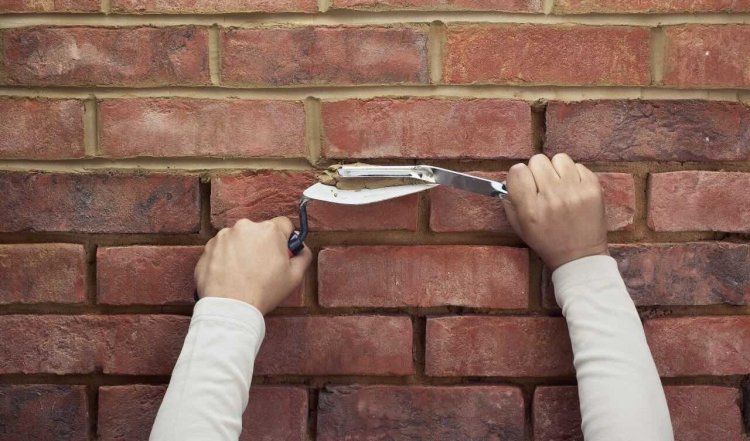Key Aspects to Ensure for Measuring Brick Wall Repointing
M&C Paving Northeast is a trusted name in the paving and landscaping industry, known for delivering high-quality workmanship.

Brick wall repointing:
Brick wall repointing is a vital maintenance activity that helps restore masonry's structural integrity and aesthetic appeal. The process involves renewing the outer portion of mortar joints between bricks, which deteriorate over time due to weathering, pollution, and general wear. Before undertaking any repointing project, measuring and evaluating specific aspects is crucial to ensure the work is efficient and effective.
Assessing the Condition of the Wall
Before starting any brick wall repointing work, thoroughly assessing the brick wall's condition is essential. This involves:
Identifying Damaged Areas:
Look for visible cracks, crumbling mortar, or gaps between bricks. Pay attention to areas exposed to excessive moisture or direct sunlight, as they deteriorate faster.
Checking for Structural Issues:
Ensure there are no underlying structural problems, such as bulging or shifting bricks. Structural damage should be addressed before proceeding with repointing.
Testing Mortar Strength:
Perform a hardness test on the existing mortar to determine whether it’s soft and needs replacement.
Measuring the Depth of the Mortar Joints
The depth of the mortar joints plays a significant role in determining the volume of materials needed and the overall durability of the repointing work. Key considerations include:
Cleaning Out Old Mortar:
Use tools like a chisel or grinder to remove loose and deteriorated mortar to a depth of at least twice the width of the joint. Ensure all debris is cleared to create a clean surface for the new mortar.
Maintaining Uniform Depth:
Consistency in depth across the wall ensures a uniform finish and better bonding of the new mortar.
Selecting the Right Mortar Mix
Choosing the appropriate mortar mix is critical to the longevity and appearance of the wall. Factors to consider include:
Compatibility with Existing Materials:
Analyse the original mortar’s composition (lime-based, cement-based, or mixed). Using incompatible mortar can lead to further deterioration of the wall.
Strength and Flexibility:
The new mortar should be softer than the bricks to allow natural movement and prevent cracking.
Colour Matching:
Match the colour of the new mortar with the existing one to maintain the wall’s visual harmony. Before proceeding, use a small test area to confirm the colour match.
Calculating the Quantity of Materials Needed
Accurate measurement and estimating materials are essential to avoid wastage or shortages during the project. Steps include:
Measuring Wall Dimensions:
Calculate the wall's total surface area to determine the required mortar volume required.
Considering Joint Size:
Consider the width and depth of the joints, as they directly affect the quantity of mortar needed.
Adding a Buffer:
Include a margin of extra material (typically 10-15%) for any unforeseen issues.
Ensuring Proper Tools and Equipment
Having the right tools ensures precision and efficiency. Essential tools for repointing include:
Trowels and Pointing Tools:
For applying and shaping the mortar within the joints.
Mortar Rake or Grinder:
Remove old mortar without damaging adjacent bricks.
Brushes and Hose:
This cleans the joints and moistens the area before applying new mortar.
Mixing Tools:
Prepare the mortar to the correct consistency.
Checking Weather Conditions
Weather plays a significant role in the success of repointing work. Consider the following:
Temperature and Humidity:
Avoid repointing in extreme heat or cold, as these conditions can affect the setting of the mortar.
Rain Protection:
Ensure the wall is shielded from rain during and after the repointing process.
Drying Time:
Allow sufficient time for the mortar to cure without exposure to harsh weather conditions.

Ensuring Safety Measures
Repointing often involves working at heights and handling tools. Safety precautions include:
Using Scaffolding or Ladders:
Ensure these are stable and securely positioned.
Wearing Protective Gear:
Use safety goggles, gloves, and dust masks to protect against debris and dust.
Avoiding Hazardous Practices:
Be cautious when using power tools to prevent accidents.
Testing and Finishing
Once the repointing is complete, perform a final inspection to ensure the work meets quality standards:
Checking for Gaps or Uneven Areas:
Inspect the joints for uniformity and fill any gaps with additional mortar.
Cleaning Excess Mortar:
Remove any excess mortar from the surface of the bricks to achieve a clean finish.
Allowing Proper Curing:
Let the mortar cure fully before exposing the wall to heavy rain or extreme conditions.
Conclusion:
Whether you want to enhance your property's curb appeal or require a practical, long-lasting surface, M&C Paving Northeast ensures exceptional results tailored to your needs. With a customer-centric approach, competitive pricing, and a team of skilled professionals, they are a reliable choice for all your paving and landscaping requirements.
What's Your Reaction?















